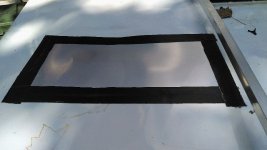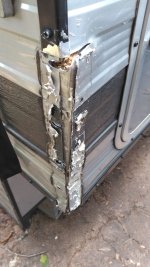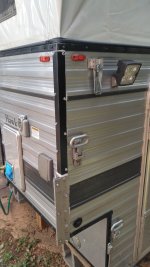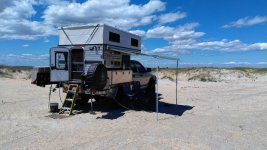FAW3
Adventurer
This was NOT part of my fall plans:
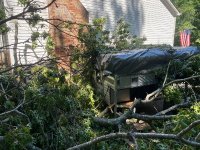
We had a severe storm in No. Virginia and a large tree limb fell onto my house and the parked FWC Hawk camper.
The limb put a palm sized hole through the roof shingles and underlayment and ripped up two sections of vinyl wall siding on the house.
The Hawk was off the truck and lightly on the jacks and on a set of blocks and cribbing. The limb impact perforated the roof with a tear about 17"x2" and knocked the Hawk off the blocks and bent the rear jack mounts. On the right rear side the internal frame member at the corner is broken at the top of the jack mount (discovered after removing the jack plate).
Roof damage:
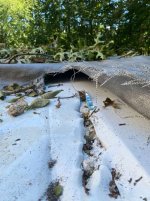
Left Rear:
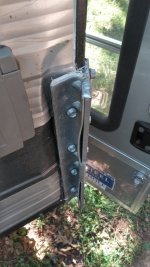
Right rear:
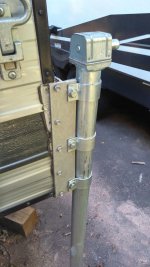
The evening of the storm we used a high lift and a floor jack to get the Hawk up a bit and put it back on the blocks and cribbing. We recovered the camper with a spare tarp and thus we avoided having extensive water damage through the roof over the next few days. We also unbolted the rear jacks from the jack plates and removed them.
The next step we took was on the first decently sunny day we uncovered the Hawk and cleaned up the roof penetration area. I bent the metal flat as best I could. I used Flex-Seal brand tape to make a temporary patch and covered the hole. This tape is excellent for this type of repair, it is easy to work with and seals well. It came in a roll 4" wide so a couple of overlapping strips sealed this problem perfectly. With the roof temporarily sealed we raised up the roof and although it is bent a bit, it lifted into place easily and the front and rear panels locked into place.
Good stuff: Flex Seal Tape
My next step was to remove the rear jack plates and inspect the damage to the body of the camper. Several of the mounting bolts had been stripped out of the frame and on the right rear side of the camper at the upper edge of the jack plate I found that the internal aluminum frame member was severed.
I need to address and repair these two primary issues, and so far, my thoughts are:
1: Roof penetration: My plan here is to cut away the buggered up edges of the hole and to the degree possible restore the panel to being flat. I'll then use a section of white finished aluminum flashing to patch the hole with a good overlap beyond the edges. I'll affix the panel with a permanent bonding/sealing agent like 3M 5200. Considering using a few pop rivets for the corners & long edges also. I'll finish the aluminum patch edges with strips of the White Flex Seal tape.
2: Rear corners/frame damage: I've already successfully re-bent the corner jack plates to square, they can be reused. I'm planning to completely remove the 1/2" wide black aluminum trim corners used to seal the exterior corners on an FWC camper. I'll replace these light trim sections with a full length of 90 degree 1/8" thick aluminum angle stock that is 1 1/4" wide. This will be affixed to the corners and be bolted/screwed into position for the complete 34" length of the camper corner. The OEM jack plates will be through bolted to this angle stock and into the frame. For some points along these aluminum strips I may be able to access the interior and will try some bolts with backing plates to add some additional strength. My thought is that by doing a reinforcement for the entire corner assembly I'll end up with a suitable and sound repair for the structural damage. I'll use butyl caulking tape or similar under the entire length of the aluminum angle stock to seal the corners from water intrusion. These will then be painted black to match the other corner trim.
At least that's the plan for now.
I'll post up as I make progress.

We had a severe storm in No. Virginia and a large tree limb fell onto my house and the parked FWC Hawk camper.
The limb put a palm sized hole through the roof shingles and underlayment and ripped up two sections of vinyl wall siding on the house.
The Hawk was off the truck and lightly on the jacks and on a set of blocks and cribbing. The limb impact perforated the roof with a tear about 17"x2" and knocked the Hawk off the blocks and bent the rear jack mounts. On the right rear side the internal frame member at the corner is broken at the top of the jack mount (discovered after removing the jack plate).
Roof damage:

Left Rear:

Right rear:

The evening of the storm we used a high lift and a floor jack to get the Hawk up a bit and put it back on the blocks and cribbing. We recovered the camper with a spare tarp and thus we avoided having extensive water damage through the roof over the next few days. We also unbolted the rear jacks from the jack plates and removed them.
The next step we took was on the first decently sunny day we uncovered the Hawk and cleaned up the roof penetration area. I bent the metal flat as best I could. I used Flex-Seal brand tape to make a temporary patch and covered the hole. This tape is excellent for this type of repair, it is easy to work with and seals well. It came in a roll 4" wide so a couple of overlapping strips sealed this problem perfectly. With the roof temporarily sealed we raised up the roof and although it is bent a bit, it lifted into place easily and the front and rear panels locked into place.
Good stuff: Flex Seal Tape
My next step was to remove the rear jack plates and inspect the damage to the body of the camper. Several of the mounting bolts had been stripped out of the frame and on the right rear side of the camper at the upper edge of the jack plate I found that the internal aluminum frame member was severed.
I need to address and repair these two primary issues, and so far, my thoughts are:
1: Roof penetration: My plan here is to cut away the buggered up edges of the hole and to the degree possible restore the panel to being flat. I'll then use a section of white finished aluminum flashing to patch the hole with a good overlap beyond the edges. I'll affix the panel with a permanent bonding/sealing agent like 3M 5200. Considering using a few pop rivets for the corners & long edges also. I'll finish the aluminum patch edges with strips of the White Flex Seal tape.
2: Rear corners/frame damage: I've already successfully re-bent the corner jack plates to square, they can be reused. I'm planning to completely remove the 1/2" wide black aluminum trim corners used to seal the exterior corners on an FWC camper. I'll replace these light trim sections with a full length of 90 degree 1/8" thick aluminum angle stock that is 1 1/4" wide. This will be affixed to the corners and be bolted/screwed into position for the complete 34" length of the camper corner. The OEM jack plates will be through bolted to this angle stock and into the frame. For some points along these aluminum strips I may be able to access the interior and will try some bolts with backing plates to add some additional strength. My thought is that by doing a reinforcement for the entire corner assembly I'll end up with a suitable and sound repair for the structural damage. I'll use butyl caulking tape or similar under the entire length of the aluminum angle stock to seal the corners from water intrusion. These will then be painted black to match the other corner trim.
At least that's the plan for now.
I'll post up as I make progress.
Last edited:

